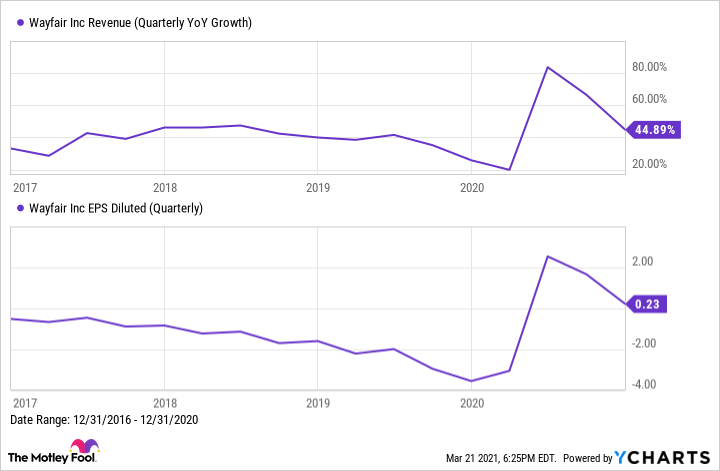Online furniture retailer Wayfair (W -1.59%) reaffirmed its status as an e-commerce powerhouse during the pandemic by scoring high sales growth and meeting surging demand from customers.
One of the company's key customer demographics is millennials, who also make up a major pillar of Wayfair's growth strategy. Millennials fall in the 20-to-40 age bracket, typically the years when people are first getting married and buying homes. They're also often moving for work and establishing themselves in their careers.
In this stage of their lives, Wayfair is positioning itself to meet their needs and winning their loyalty in the process.

Image source: Getty Images.
What's to love about Wayfair
Wayfair is an online furniture retailer (with the exception of one brick-and-mortar outlet store in Kentucky) that has grown into a $35 billion company in less than 20 years. The idea behind the company is simple, but it serves the growing demand in a world shifting to digital shopping, and customers love it. Customer satisfaction is high as repeat buyers typically account for around 70% of total orders.
Sales were growing at low double-digit rates before the pandemic, and that was enough to impress investors. But Wayfair was still posting a loss through the first quarter of 2020.
Data by YCharts.
That all changed when lockdowns and social distancing became the norm, accelerating the shift to e-commerce. The company's second-quarter sales increased 84% year over year, and earnings surged to $2.54 per share.
High growth continued through the third and fourth quarters, with full-year 2020 revenue ultimately reaching $14.1 billion, up 55%, with earnings per share of $1.86.
So where do millennials fit into this story? Well, they're the biggest digital spenders, along with high earners, according to a report from consulting firm McKinsey. This 72-million strong generation grew up with e-commerce and are quite comfortable buying all sorts of products online, including furniture and other household items.
Omnichannel retail, which typically involves the integration of physical and digital capabilities, is becoming the most popular approach for companies to meet every kind of shopping need. But as an almost exclusively digital operation, Wayfair leverages technology to provide unique services such as augmented reality, which allows customers to simulate how a piece of furniture would look in their homes. The company has also developed the infrastructure to quickly ship large, bulky, and often delicate pieces of furniture all over the country.
As a technology-first company, Wayfair invests in search, marketing, and visual details that help it stand out from traditional retailers that are just getting online.

Image source: Getty Images.
Can the story continue?
Yes. The company is making moves to build on its 2020 momentum, such as expanding its product assortment for its business-to-business category; bringing on new appliance brands; and making a deal with Citi to offer better financing terms so customers have greater flexibility in paying for the products they need.
CEO Niraj Shah also hinted the company may eventually open more physical storefronts if that's where it can meet customers where they are.
By 2030, Wayfair estimates there will be a $1.2 trillion addressable market for the "home category," a category where it currently holds just a low single-digit market share . Management envisions growing sales to over eight times 2020 levels in the next decade, which would result in a compound annual growth rate of more than 20%.
Wayfair shareholders have been richly rewarded over the past year as the stock gained over 1,000%, and shares are already up another 49% year to date. However, those stellar gains mean the stock comes with a rich valuation of 180 times trailing 12-month earnings.
That doesn't mean the market potential for Wayfair investors is finished. As consumers continue to outfit their homes with Wayfair products and the company expands its reach into new opportunities, its long-term growth story should at a minimum put Wayfair on your watchlist.






